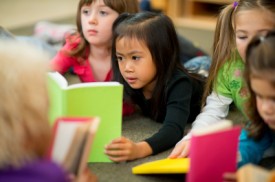
A few weeks ago, a commercial came on TV that immediately caught both my husband’s and my attention. A young boy walked to home plate of a baseball field with a bat and ball and repeatedly threw the ball in the air and then tried to hit it with the bat. Before each attempt to hit the ball, he would yell, “I’m the greatest hitter in the world!” He tried a couple of times with no success so he paused to rethink his strategy, adjusted his ball cap, gave his “greatest” yell and tried again. When he had the same result, he stood there dejectedly for a moment then suddenly looked up, a new thought dawning, and with big grin yelled, “Wow, I’m the greatest pitcher in the world!”
What a great optimistic attitude! Wouldn’t it be wonderful if all of our students were willing to try and try again and, if their efforts still didn’t work, change their tactics to find success? Unfortunately, with many students we don’t see that attitude of perseverance because they have had years of being unsuccessful and have become disengaged in what was happening in school. I wonder how often this is related to a classroom disconnect with their cognitive learning styles.
Recently, Sherrelle Walker had a post on introverted students in the classroom. This blog talked about the importance of understanding the outlook of introverted students and maximizing their strengths. By using a student-centered approach, teachers can incorporate activities that “speak” to various learning styles to ensure that each student will have his or her best opportunity for learning. As Sherrelle mentioned, some students thrive on group activities while those can be a nightmare for students who don’t really learn effectively while working with others. Finding a way to consider all of our students’ cognitive learning needs and then using activities to help all students engage in the learning process consistently is what the student-centered classroom is all about.
The teacher in the student-centered classroom is a learning guide who manages the activities and directs student learning but who does this through activities that require students to engage is a variety of ways – perhaps working in groups, teaming in pairs or focusing independently at different times. By varying these strategies, and considering the learning styles of each student, we can maximize their learning potential.
For example, some students may need to touch things or use manipulatives in order to solve problems or understand a process while others may prefer to brainstorm or experiment with different methods to find a workable solution. Neither one is right or wrong; they are just different ways to solve a problem. It is important for both teachers and students to learn their cognitive learning styles – how they take in information and then make decisions based on that information. You may have some students who are more sensory so need clear instructions and examples and who like to practice with a hands-on approach. Other students are more intuitive and want to make connections and play out their own hunches rather than practicing tasks repeatedly. How teachers provide instruction and feedback (do they need more direct instruction or just a few probing questions?) can help these students get the most from their classroom learning time.
So, what can we, as teachers, do to develop a classroom that enhances all student learning? First, we need to do some research – seek information about different types of cognitive learning styles and what activities best engage different types of learners. Then we can shift the focus of our teaching strategies to help students become actively engaged in their own learning process rather than waiting for us to “feed” information to them. It may require some different planning and methodology on our part but is well worth the effort.
Who knows? With newly energized teaching strategies and a new-found love of learning in our students, we each might develop our own “I’m the greatest” yell!
For Further Reading:
Student-Centered Learning Strategies for Math and Other Subjects

